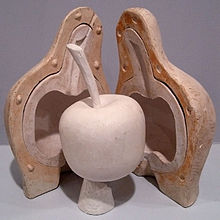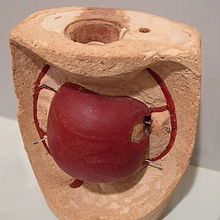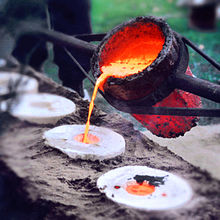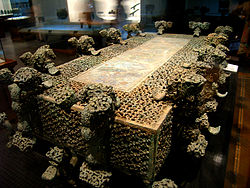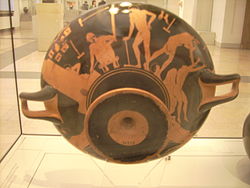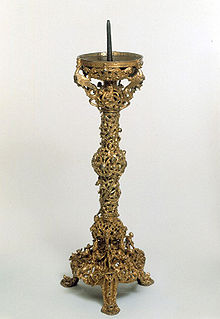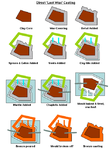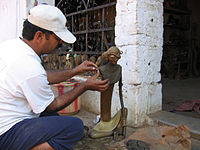- Lost-wax casting
-
Lost-wax casting sometimes called by the French name of cire perdue (from the Latin cera perduta) is the process by which a metal (such as silver, gold, brass or bronze) sculpture is cast from an artist's sculpture. Intricate works can be achieved by this method, primarily depending on the carver's skills. In industrial uses, the modern process is called investment casting. An ancient practice, the process today varies from foundry to foundry, but the steps which are usually used in casting small bronze sculptures in a modern bronze foundry are generally quite standardized.
Other names for the process include "lost mould," which recognizes that other materials besides wax can be used, including tallow, resin, tar, and textile;[1] and "waste wax process" or "waste mould casting", because the mould is destroyed to unveil the cast item.[2][3] Other methods of casting include open casting, bivalve mould, and piece mould.[3][4] Lost-wax casting was widespread in Europe until 18th century, when a piece-mold process came to predominate.
Contents
Process
Casts can be made of the wax model itself, the direct method; or of a wax copy of a model that need not be of wax, the indirect method. These are the steps for the indirect process:
- Model-making. An artist or mold-maker creates an original model from wax, clay, or another material. Wax and oil-based clay are often preferred because these materials retain their softness.
- Moldmaking. A mold is made of the original model or sculpture. The rigid outer molds contain the softer inner mold, which is the exact negative of the original model. Inner molds are usually made of latex, polyurethane rubber or silicone, which is supported by the outer mold. The outer mold can be made from plaster, but can also be made of fiberglass or other materials. Most molds are at least two pieces, and a shim with keys is placed between the two halves during construction so that the mold can be put back together accurately. In case there are long, thin pieces sticking out of the model, these are often cut off of the original and molded separately. Sometimes many molds are needed to recreate the original model, especially for large models.
- Wax. Once the mold is finished, molten wax is poured into it and swished around until an even coating, usually about 1⁄8 inch (3 mm) thick, covers the inner surface of the mold. This is repeated until the desired thickness is reached. Another method is filling the entire mold with molten wax, and letting it cool, until a desired thickness has set on the surface of the mold. After this the rest of the wax is poured out again, the mold is turned upside down and the wax layer is left to cool and harden. With this method it is more difficult to control the overall thickness of the wax layer.
- Removal of wax. This hollow wax copy of the original model is removed from the mold. The model-maker may reuse the mold to make multiple copies, limited only by the durability of the mold.
- Chasing. Each hollow wax copy is then "chased": a heated metal tool is used to rub out the marks that show the parting line or flashing where the pieces of the mold came together. The wax is dressed to hide any imperfections. The wax now looks like the finished piece. Wax pieces that were molded separately can be heated and attached; foundries often use registration marks to indicate exactly where they go.
- Spruing. The wax copy is sprued with a treelike structure of wax that will eventually provide paths for molten casting material to flow and air to escape. The carefully planned spruing usually begins at the top with a wax "cup," which is attached by wax cylinders to various points on the wax copy. This spruing doesn't have to be hollow, as it will be melted out later in the process.
- Slurry. A sprued wax copy is dipped into a slurry of silica, then into a sand-like stucco, or dry crystalline silica of a controlled grain size. The slurry and grit combination is called ceramic shell mold material, although it is not literally made of ceramic. This shell is allowed to dry, and the process is repeated until at least a half-inch coating covers the entire piece. The bigger the piece, the thicker the shell needs to be. Only the inside of the cup is not coated, and the cup's flat top serves as the base upon which the piece stands during this process.
- Burnout. The ceramic shell-coated piece is placed cup-down in a kiln, whose heat hardens the silica coatings into a shell, and the wax melts and runs out. The melted wax can be recovered and reused, although often it is simply burned up. Now all that remains of the original artwork is the negative space, formerly occupied by the wax, inside the hardened ceramic shell. The feeder and vent tubes and cup are also hollow.
- Testing. The ceramic shell is allowed to cool, then is tested to see if water will flow through the feeder and vent tubes as necessary. Cracks or leaks can be patched with thick refractory paste. To test the thickness, holes can be drilled into the shell, then patched.
- Pouring. The shell is reheated in the kiln to harden the patches and remove all traces of moisture, then placed cup-upwards into a tub filled with sand. Metal is melted in a crucible in a furnace, then poured carefully into the shell. If the shell were not hot, the temperature difference would shatter it. The filled shells are allowed to cool.
- Release. The shell is hammered or sand-blasted away, releasing the rough casting. The sprues, which are also faithfully recreated in metal, are cut off, to be reused in another casting.
- Metal-chasing. Just as the wax copies were chased, the casting is worked until the telltale signs of the casting process are removed, and the casting now looks like the original model. Pits left by air bubbles in the casting, and the stubs of spruing are filed down and polished.
Prior to silica-based casting molds, these molds were made of a variety of other fire-proof materials, the most common being plaster based, with added grout, and clay based. Prior to rubber molds gelatine was used.
Casting jewellery and small parts
The methods used for small parts and jewellery vary a bit from those used for sculpture. A wax is obtained, either from injection into a rubber mold, or it is custom-made in wax. Occasionally, a custom-made wax might be molded in rubber first as insurance against the loss of the unique wax and related labor costs incurred in carving it. The wax or waxes are sprued and fused onto a rubber base, called a "sprue base". Then a metal flask, which resembles a short length of steel pipe that ranges roughly from 1.5 to six inches tall and wide, is put over the sprue base and the waxes. Most sprue bases have a circular rim which grips the standard-sized flask, holding it in place. Investment (refractory plaster) is mixed and poured into the flask, filling it. It hardens, then is burned out as outlined above. Casting is usually done straight from the kiln either by centrifugal casting or vacuum casting.
The lost-wax process can be used with any material that can burn, melt, or evaporate to leave a mold cavity. Some automobile manufacturers use a lost-foam technique to make engine blocks. The model is made of polystyrene foam, which is placed into a casting flask, consisting of a cope and drag, which is then filled with casting sand. The foam supports the sand, allowing shapes that would be impossible if the process had to rely on the sand alone. The metal is poured in, vaporizing the foam with its heat.
Textile use
In this process, the wax and the textile were both replaced by the metal during the casting process, whereby the fabric reinforcement would allow for a thinner model, and thus reduce the amount of metal expended in the mould.[5] Evidence of this process is seen by the textile relief on the reverse side of objects and is sometimes referred to as "lost-wax, lost textile". This textile relief is visible on gold ornaments from burial mounds in southern Siberia of the ancient horse riding tribes, such as the distinctive group of openwork gold plaques housed in the Hermitage Museum, Leningrad[5] The technique may have its origins in the Far East, as indicated by the few Han examples, and the bronze buckle and gold plaques found at the cemetery at Xigou.[6] Such a technique may also have been used to manufacture some Viking Age oval brooches, indicated by numerous examples with fabric imprints such as that of Castletown (Scotland).[7]
History
Indirect literary evidence
Some early literary works allude to lost-wax casting. Columella, a Latin writer of the first century AD, mentions the processing of wax from beehives in De Re Rustica, perhaps for casting, as does Pliny the Elder,[8] who details a sophisticated procedure for making Punic wax.[9] One Greek inscription refers to the payment of craftsmen for their work on the Erechtheum in Athens (408/7-407/6 BC). Clay-modellers may be using clay moulds to make terracotta negatives for casting or to produce wax positives.[9] Pliny portrays[8] Zenodorus as a well-reputed ancient artist of bronze statues,[10] and describes[8] Lysistratos of Sikyon, who takes plaster casts from living faces to create wax casts using the indirect process.[10]
Many bronze statues or parts of statues in antiquity were cast using the lost wax process. Theodorus of Samos is commonly associated with bronze casting.[8][11] Pliny also mentions the use of lead, which is known to help molten bronze flow into all areas and parts of complex moulds.[12] Quintilian documents the casting of statues in parts, whose moulds may have been produced by the lost wax process. Scenes on the early-5th century BC Berlin Foundry Cup depict the creation of bronze statuary working, probably by the indirect method of lost-wax casting.[13]
Direct literary evidence
India
The lost-wax method is well documented in ancient Indian literary sources. The Silpasastras, a text from the Gupta Period, contains detailed information about casting images in metal. The fifth-century AD Vishnusamhita, an appendix to the Vishnu Purana, refers directly to the modeling of wax for making metal objects in chapter XIV: "if an image is to be made of metal, it must first be made of wax.”[14] Chapter 68 of the ancient Sanskrit text Mānasāra Silpa details casting idols in wax and is entitled "Maduchchhista vidhānam", or "lost wax method".[14][15] The Mānasollāsa (also known as the Abhilasitārtha chintāmani) was allegedly written by King Bhūlokamalla Somesvara of the Chalukya dynasty of Kalyāni in AD 1124-1125, and also provides detail about lost-wax and other casting processes.[14][15]
In a 16th-century treatise, the Uttarabhaga of the Śilparatna written by Srïkumāra, verses 32 to 52 of Chapter 2 ("Linga lakshanam") give detailed instructions on making a hollow casting.[14][15]
Theophilus
Early medieval writer Theophilus Presbyter, believed to be the Benedictine monk and metalworker Roger of Helmarshausen, wrote a treatise in the early to mid-12th century[16] that includes original work and copied information from other sources, such as the Mappae clavicula and Eraclius, De dolorous et artibus Romanorum.[16] It provides step-by-step procedures for making various articles, some by lost-wax casting: "The Copper Wind Chest and Its Conductor" (Chapter 84); "Tin Cruets" (Chapter 88), and "Casting Bells" (Chapter 85), which calls for using "tallow" instead of wax; "The Cast Censer". In Chapters 86 and 87 Theophilus details how to divide the wax into differing ratios, before moulding and casting, to achieve accurately tuned small musical bells. The 16th-century Florentine sculptor Benvenuto Cellini may have used Theophilus' writings when he cast his bronze Perseus.[15][17]
The Conquistadors
The lost-wax process was known to the Incas, the Aztecs and the Maya, as shown by archaeological evidence and a brief 1596 account of Aztec casting by the Spanish writer Releigh.[15]
Lost-wax process in archaeology
South Asia
Metalcasting began in India (now Pakistan) around 3500 BC in the Mohenjodaro area,[14] which produced earliest known lost-wax casting, the Indian bronze figurine named the “dancing girl” that dates back nearly 5,000 years to the Harappan period.[14][15] Other examples include the buffalo, bull and dog found from Mohenjodaro and Harappa,[1][15][18] two copper figures found at the Harappan site Lothal in the district of Ahmedabad of Gujurat,[14] and likely the covered cart with wheels missing and a complete cart with a driver found at Chanhudaro.[1][18]
During the post-Harappan period, hoards of copper and bronze implements made by the lost-wax process are known from Uttar Pradesh, Bihar, Madhya Pradesh, Orissa, Andhra Pradesh and West Bengal.[14] Gold and copper ornaments, apparently Hellenistic in style, made by cire perdue are found at the ruins at Sirkap. One example of this Indo-Greek art dates to the 1st century BC, the juvenile figure of Harpocrates excavated at Taxila.[14] Bronze icons were produced during the 3rd and 4th centuries AD, such as the Buddha image at Amaravati, the images of Rama and Kartikeya in the Guntur district of Andhra Pradesh.[14] A further two bronze images of Parsvanatha and a small hollow-cast bull were come from Sahribahlol, Gandhara, as well as the standing Tirthankara (2nd, 3rd century AD) from Chausa in Bihar.[14] Other notable bronze figures and images have been found in Rupar, Mathura (in Uttar Pradesh) and Brahmapura, Maharashtra.[14]
Gupta and post-Gupta period bronze figures have been recovered from the following sites: Saranath, Mirpur-Khas (in Pakistan), Sirpur (District of Raipur), Balaighat (near Mahasthan now in Bangladesh), Akota (near Vadodara, Gujurat), Vasantagadh, Chhatarhi, Barmer and Chambi (in Rajesthan).[14] Producing images by the lost-wax process reached its peak during from 750 AD to 1100 AD, and still remained prevalent in south India between 1500 AD and 1850.[14] The technique still remains well practiced throughout India, as well as neighbouring countries Nepal, Tibet, Ceylon, Burma and Siam.[15]
East Asia
There is great variability in the use of the lost-wax method in South East Asia. The casting method of bronze during the Shang and Chou dynasties (approximately 1500 BC to 500 BC) has commonly been assumed to be by the lost-mould method.[15] Further investigations have revealed this not to be the case as it is clear that the piece-mould casting method was the principal technique used to manufacture bronze vessels in China.[19] The lost-wax technique did not appear in northern China until the 6th century BC.[20] Lost-wax casting is known as ro-gata in Japanese, and dates back to the Yayoi period of circa 200 BC.[15] The most famous piece made by cire perdue is the bronze image of Buddha in the temple of the Todaiji monastery at Nara.[15] It was made in sections between 743 AD and 749 AD, allegedly using seven tons of wax.[15]
Southeast Asia
Bangles (virtually non-existent in second millennium China) made by the lost-wax process are characteristic of northeast Thailand.[20] The inhabitants of Ban Na Di were casting bronze between 1200 BC and 200 AD, using the lost-wax technique to manufacture their bangles.[21] Some of the bangles from Ban Na Di revealed a dark grey substance between the central clay core and the metal, which on analysis was identified as an unrefined form of insect wax.[20][21] It is likely that decorative items, like bracelets and rings, were made by cire perdue at Non Nok Tha and Ban Chiang.[1]
There are technological and material parallels between northeast Thailand and Vietnam concerning the lost-wax technique.[1] The sites exhibiting artifacts made by the lost-mould process in Vietnam, such as the Dong Son drums come from the Dong Son,and Phung Nguyen cultures,[1] such as one sickle and the figure of a seated individual from Go Mun (near Phung Nguyen, the Bac Bo Region), dating to the Go Mun phase (end of the General B period, up until the 7th century BC).[21]
Near East
The lost-wax technique was used and developed for small-scale, and then large-scale, statues from circa 3500 BC to 2750 BC in Mesopotamia, made of copper and bronze.[22] A small lion pendant from Uruk IV was cast by cire perdue,one of the earliest surviving lost-wax castings, however, earlier lost-wax object examples come from the Nahal Mishmar hoard (Israel) made circa 3700 BC.[22][23] The Sumerian metalworkers were practicing lost-wax casting from approximately 3500 BC to 3200 BC.[24] Much later examples from northeastern Mesopotamia/Anatolia include the Great Tumulus at Gordion (end of 8th century BC), as well as other types of Urartian cauldron attachments.[25]
Ancient Egypt
The Egyptians were practicing cire perdue from the mid 3rd millennium BC, shown by Early Dynastic bracelets and gold jewellery.[26][27] Inserted spouts for ewers (copper water vessels) from the Fourth Dynasty (Old Kingdom) were made by the lost-wax method.[27][28] Hollow castings, such as the Louvre statuette from the Fayum find appear during the Middle Kingdom, followed by solid cast statuettes (like the squatting, nursing mother, in Brooklyn) of the Second Intermediate/Early New Kingdom.[28] The hollow casting of statues is represented in the New Kingdom by the kneeling statue of Tuthmosis IV (British Museum, London) and the head fragment of Ramesses V (Fitzwilliam Museum, Cambridge).[29] Hollow castings become more detailed and continue into the Eighteenth Dynasty, shown by the black bronze kneeling figure of Tutankhamun (Museum of the University of Pennsylvania). Cire Perdue is used in mass-production during the Late Period to Graeco-Roman time when figures of deities are cast for personal devotion and votive temple offerings.[24] The nude-woman shaped handles of bronze mirrors are cast by the lost-wax process.[24]
Classical Greek and Roman, and the Mediterranean
The lost-wax technique was known in the Aegean during the Bronze Age, particularly in the second millennium BC.[30] Direct imitations and local derivations of Oriental, Syro-Palestinian and Cypriot figurines are found in Late Bronze Age Sardinia, with a local production of figurines from the eleventh to tenth century BC.[30]
Some Late Bronze Age sites in Cyprus have produced cast bronze figures of humans and animals: one example is the male figure found at Enkomi.[31] Three objects from Cyprus (held in the Metropolitan Museum of Art in New York) were cast as by the lost-wax technique, from the 13th and 12th centuries BC, namely, the Amphorae Rim, the rod tripod, and the cast tripod.[31]
The cremation graves (mainly 8th-7th centuries BC, but continuing until the beginning of the 4th century from the necropolis of Paularo (Italian Oriental Alps) contained fibulae, pendants and other copper-based objects that were made by the lost-wax process.[32] Etruscan examples, such as the bronze anthropomorphic handle from the Bocchi collection (National Archaeological Museum of Adria), dating back to the 6th to 5th centuries BC, were made by cire perdue.[33] Most of the handles in the Bocchi collection, as well as some Bronze vessels found in Adria (Rovigo, Italy) were made using the lost-wax technique.[33]
The better known lost-wax produced items from the classical world include the “Praying Boy” circa 300 BC (in the Berlin Museum), the statue of Hera from Vulci (Etruria), which, like most statues, were cast in several parts and then joined together.[34] Other, earlier examples that show this assembly of lost-wax cast pieces include the bronze head of the Chatsworth Apollo, and the bronze head of Aphrodite from Satala (modern Turkey, formerly Armenia) from the British Museum.[35] Geometric bronzes such as the four copper horses of San Marco (Venice, probably 2nd century) are other prime examples of statues cast in many parts.[27]
Africa
Cast bronzes were produced in Africa by the kingdoms of Benin, Yorubaland, Ife and in Igboland, including Igbo-Ukwu in Nigeria. Some portrait heads remain.[15]
Latin America
The lost-wax casting tradition was developed by the peoples of Nicaragua, Costa Rica, Panama, Colombia, northwest Venezuela, Andean America, and the western portion of South America.[36] Lost-wax casting produced some of the region's typical gold wire and delicate wire ornament, such as fine ear ornaments. The process was employed in prehispanic times in Colombia's Muisca and Sinú cultural areas.[37] Two lost-wax moulds, one complete and one partially broken, were found in a shaft and chamber tomb in the vereda of Pueblo Tapado in the municipio of Montenegro (Department of Quindío), dated roughly to the pre-Columbian period.[38] The lost-wax method did not appear in Mexico until the 10th century,[39] and was thereafter used in western Mexico to make a wide range of bell forms.[40]
Early medieval Europe
The intricate Gloucester candlestick (1104-1113 AD) was made as a single-piece wax model, then given a complex system of gates and vents before being invested in a mould.[3] The Dunaverney (1050 – 910 BC) and Little Thetford (1000 – 701 BC) flesh-hooks have been shown to be made using a lost-wax process. The Little Thetford flesh-hook, in particular, employed distinctly inventive construction methods.[41][42]
Gallery
-
This piece entitled Lazy Lady, by the sculptor Rowan Gillespie is created out of bronze, and cast using the lost wax process.
-
This sculpture entitled An Uncertain Situation by the artist David Reekie, is created using the 'lost wax' process. It is cast out of coloured Glass.
-
The Darwin Monkey (after Hugo Rheinhold's Affe mit Schädel) is cast out of bronze using the 'lost wax' process.
References
- ^ a b c d e f Agrawal, D. P. (2000). Ancient Metal Technology and Archaeology of South Asia. A Pan-Asian Perspective. New Delhi: Aryan Books International.
- ^ McCreight, T., 1991. The Complete Metalsmith. An Illustrated Handbook., Worcester, Massachusetts: Davis Publications, Inc.
- ^ a b c Maryon, H., 1954. Metalwork and Enamelling. A Practice Treatise on Gold and Silversmiths' Work and their Allied Crafts., London: Chapman & Hall Ltd.
- ^ Maryon, H. & H. J. Plenderleith, (1954). Fine Metal-Work, in A History of Technology. Volume I: From Early Times to Fall of Ancient Empires, ed. E. J. H. Charles Singer, A. R. Hall Oxford: Clarendon Press.
- ^ a b Bunker, E. C. (1988). Maddin, R.. ed. Lost Wax and Lost Textile: An Unusual Ancient Technique for Casting Gold Belt Plaques. The Beginning of the Use of Metals and Alloys. Papers from the Second International Conference on the Beginning of the Use of Metals and Alloys, Zhengzhou, China, 21–26 October 1986. Cambridge, Massachusetts: The MIT Press.
- ^ Zhungeer Banner, western inner Mongolia, 3rd-1st centuries BC
- ^ Smith, M. H., (2005). Breaking the Mould: A Re-evaluation of Viking Age Mould-making Techniques for Oval Brooches, in De Re Metallica. The Uses of Metal in the Middle Ages, ed. R. Bork Aldershot: Ashgate.
- ^ a b c d Pliny (77). Natural History.
- ^ a b Humphrey, J. W., J. P. Oleson & A. N. Sherwood, 1998. Greek and Roman Technology: A Sourcebook. Annotated Translations of Greek and Latin Texts and Documents, London and New York: Routledge.
- ^ a b Jex-Blake, K. & E. Sellers, 1967. The Elder Pliny's Chapters on The History of Art., Chicago: Ares Publishers, Inc.
- ^ Pausania, Description of Greece 8.14.8
- ^ Hurcombe, L. M., 2007. Archaeological Artifacts as Material Culture, London and New York: Routledge.
- ^ Mattusch, C. C., 1980. The Berlin Foundry Cup: The Casting of Greek Bronze Statuary in the Early Fifth Century B.C. American Journal of Archaeology, 84(4), 435-44.
- ^ a b c d e f g h i j k l m n Kuppuram, G., 1989. Ancient Indian Mining, Metallurgy and Metal Industries, Delhi: Ashish Singhal.
- ^ a b c d e f g h i j k l m Krishnan, M. V., 1976. Cire Perdue Casting in India, New Delhi: Kanak Publications.
- ^ a b Hawthorne, J. G. & C. S. Smith, 1979. Theophilus. On Divers Arts. The Foremost Medieval Treatise on Painting, Glassmaking and Metalwork. Translated from the Latin with Introduction and Notes by John G. Hawthorne and Cyril Stanley Smith., New York: Dover Publications.
- ^ D., M., 1944. Cire Perdue. The Scientific Monthly, 58(2), 158.
- ^ a b Kenoyer, J. M. & H. M.-L. Miller, (1999). Metal Technologies of the Indus Valley Tradition in Pakistan and Western India., in The Archaeometallurgy of the Asian Old World., ed. V. C. Pigott. Philadelphia: The University of Pennsylvania Museum.
- ^ Meyers, P. (1988). Characteristics of Casting Revealed by the Study of Ancient Chinese Bronzes, in The Beginning of the Use of Metals and Alloys. Papers from the Second International Conference on the Beginning of the Use of Metals and Alloys, Zhengzhou, China, 21–26 October 1986., ed. R. Maddin Cambridge, Massachusetts & London, England: The MIT Press.
- ^ a b c White, J. C. (1988). Early East Asian Metallurgy: The Southern Tradition, in The Beginning of the Use of Metals and Alloys. Papers from the Second International Conference on the Beginning of the Use of Metals and Alloys, Zhengzhou, China, 21–26 October 1986., ed. R. Maddin Cambridge, Massachusetts & London, England: The MIT Press.
- ^ a b c Higham, C. (1988). Prehistoric Metallurgy in Southeast Asia: Some New Information from the Excavation of Ban Na Di, in The Beginning of the Use of Metals and Alloys. Papers from the Second International Conference on the Beginning of the Use of Metals and Alloys, Zhengzhou, China, 21–26 October 1986., ed. R. Maddin Cambridge, Massachusetts & London, England: The MIT Press.
- ^ a b Moorey, P. R. S., (1988). Early Metallurgy in Mesopotamia, in The Beginning of the Use of Metals and Alloys. Papers from the Second International Conference on the Beginning of the Use of Metals and Alloys, Zhengzhou, China, 21–26 October 1986., ed. R. Maddin Cambridge, Massachusetts & London, England: The MIT Press.
- ^ Muhly, J. D., (1988). The Beginnings of Metallurgy in the Old World, in The Beginning of the Use of Metals and Alloys. Papers from the Second International Conference on the Beginning of the Use of Metals and Alloys, Zhengzhou, China, 21–26 October 1986., ed. R. Maddin Cambridge, Massachusetts & London, England: The MIT Press.
- ^ a b c Scheel, B., 1989. Egyptian Metalworking and Tools, Aylesbury: Shire Publications.
- ^ Azarpay, G. (1968). Urartian Art and Artifacts. A Chronological Study. Berkeley and Los Angeles: University of California Press.
- ^ Ogden, J., 1982. Jewellery of the Ancient World, London: Trefoil Books.
- ^ a b c Darling, A. S., (1990). Non-Ferrous Materials, in An Encyclopaedia of the History of Technology, ed. I. McNeil London and New York: Routledge.
- ^ a b Ogden, J. (2000). Metals, in Ancient Egyptian Materials and Technology, eds. P. T. Nicholson & I. Shaw Cambridge: Cambridge University Press.
- ^ Aldred, G.. Egyptian Art in the Days of the Pharaohs 3100 - 320 BC. London: Thames and Hudson.
- ^ a b LoSchiavo, F., (1988). Early Metallurgy in Sardinia, in The Beginning of the Use of Metals and Alloys. Papers from the Second International Conference on the Beginning of the Use of Metals and Alloys, Zhengzhou, China, 21–26 October 1986., ed. R. Maddin Cambridge, Massachusetts & London, England: The MIT Press.
- ^ a b Schorsch, D. & E. Hendrix, (2003). The Production of Relief Ornament on Cypriot Bronze Castings of The Late Bronze Age, in Archaeometallurgy in Europe. 24, 25, 26 September 2003, Milan, Italy. Proceedings.Milan: Associazione Italiana di Metallurgia.
- ^ Giumlia-Mair, A., S. Vitre & S. Corazza, (2003). Iron Age Copper-Based Finds from the Necropolis of Paularo in the Italian Oriental Alps, in Archaeometallurgy in Europe. 24, 25, 26 September 2003, Milan, Italy. Proceedings.Milan: Associazione Italiana di Metallurgia.
- ^ a b Bonomi, S.; Martini, G.; Poli, G.; Prandstraller, D. (September 2003). Modernity of Early Metallurgy: Studies on an Etruscan Anthropomorphic Bronze Handle. Archaeometallurgy in Europe. Milan: Associazione Italiana di Metallurgia.
- ^ Neuburger, A., 1930. The Technical Arts and Sciences of the Ancients, London: Methuen & Co. Ltd.
- ^ Maryon, H., (1956). Fine Metal-Work, in A History of Technology. Volume II: The Mediterranean Civilizations and The Middle Ages c. 700 B.C. to c. A.D. 1500, ed. E. J. H. Charles Singer, A. R. Hall, Trevor I. Williams Oxford: Clarendon Press.
- ^ Lechtman, H. (1988). Traditions and Styles in Central Andean Metalworking, in The Beginning of the Use of Metals and Alloys. Papers from the Second International Conference on the Beginning of the Use of Metals and Alloys, Zhengzhou, China, 21–26 October 1986., ed. R. Maddin Cambridge, Massachusetts & London, England: The MIT Press.
- ^ Scott, D. A., 1991. Technical Examination of Some Gold Wire from Pre-Hispanic South America. Studies in Conservation, 36(2), 65-75.
- ^ Bruhns, K. O. (1972). "Man". Two Prehispanic Cire Perdue Casting Moulds from Colombia..
- ^ Hodges, H., 1970. Technology in the Ancient World, London: Allen Lane The Penguin Press.
- ^ Hosler, D., (1988). The Metallurgy of Ancient West Mexico, in The Beginning of the Use of Metals and Alloys. Papers from the Second International Conference on the Beginning of the Use of Metals and Alloys, Zhengzhou, China, 21–26 October 1986., ed. R. Maddin Cambridge, Massachusetts & London, England: The MIT Press.
- ^ Bowman, Sheridan; Stuart Needham. "The Dunaverney and Little Thetford Flesh-Hooks: history, technology and their position within the Later Bronze Age Atlantic Zone feasting complex". The Society of Antiquaries of London (The Society of Antiquaries of London) 87. http://www.sal.org.uk/books/theantiquariesjournal/volume872007/. Retrieved 27 June 2010.
- ^ Bowman, S (1953). "Late Bronze Age flesh hook, Little Thetford". Cambridgeshire HER. http://www.heritagegateway.org.uk/Gateway/Results_Single.aspx?uid=MCB8392&resourceID=1000. Retrieved 27 June 2010.
- Forbes, R. J., 1971. Studies in Ancient Technology, Leiden: E. J. Brill.
- Hart, G. H. & G. Keeley, 1945. Metal Work For Craftsmen, London: Sir Isaac Pitman & Sons.
- Hodges, H., 1989. Artifacts. An Introduction to Early Materials and Technology, London: Duckworth.
- Jones, D. M. (ed.) (2001). Archaeometallurgy, London: English Heritage Publications.
- Konkova, L. V. & G. G. Korol, (2003). South Siberian Imports in Eastern Europe in the 10th - the 13th centuries: Traditions of Metalworking, in Archaeometallurgy in Europe. 24, 25, 26 September 2003, Milan, Italy. Proceedings.Milan: Associazione Italiana di Metallurgia.
- Long, S., 1964. Cire Perdue Copper Casting in Pre-Columbian Mexico: An Experimental Approach. American Antiquity, 30(2), 189-92.
- McArthur, M., 2005. The Arts of Asia. Materials, Techniques, Styles., London: Thames & Hudson.
- Noble, J. V., 1975. The Wax of the Lost Wax Process. American Journal of Archaeology, 79(4), 368-9.
- Taylor, S. E., (1978). Dark-Age Meal Casting; An Experimental Investigation into the Possibility of using Wax Models for the Formation of Clay-Piece Moulds, with special reference to the Manufacture of Pairs of Cast Objects., in The Department of Archaeology Cardiff: University of Cardiff, 97.
- Trench, L. (ed.) (2000). Materials and Techniques in the Decorative Arts. An Illustrated Dictionary., London: John Murray Publishers.
External links
- Andre Stead Sculpture - The Bronze Casting Process
- Metal Art of Bastar Photos
- "Flash animation of lost-wax casting process". James Peniston Sculpture. http://www.jepsculpture.com/bronze.shtml. Retrieved 2007-10-24.
- National Museum of Wildlife Art's Virtual Foundry
- "Casting a Medal". Sculpture. Victoria and Albert Museum. http://www.vam.ac.uk/collections/sculpture/sculpture_features/bayes/modelling/medal/index.html. Retrieved 2007-09-22.
- Reconstructing the Bronze Age Trundholm Sun Chariot
- 10/15/1904;The " Cire-perdue " Process of Bronze Casting
Jewellery Forms Anklet · Belt buckle · Belly chain · Bindi · Bracelet · Brooch · Chatelaine · Collar pin · Crown · Cufflink · Earring · Lapel pin · Necklace · Pendant · Ring · Tiara · Tie clip · Toe ring · Watch (pocket)Making PeopleProcessesCasting (centrifugal, lost-wax, vacuum) · Enameling · Engraving · Filigree · Metal clay · Plating · Polishing · Repoussé and chasing · Soldering · Stonesetting · Wire wrappingToolsMaterials Britannia silver · Colored gold · Crown gold · Electrum · Platinum sterling · Shakudo · Shibuichi · Sterling silver · TumbagaMineral gemstonesAventurine · Agate · Alexandrite · Amethyst · Aquamarine · Carnelian · Citrine · Diamond · Diopside · Emerald · Garnet · Jade · Jasper · Lapis lazuli · Larimar · Malachite · Marcasite · Moonstone · Obsidian · Onyx · Opal · Peridot · Quartz · Ruby · Sapphire · Sodalite · Sunstone · Tanzanite · Tiger's eye · Topaz · Tourmaline · TurquoiseOrganic gemstonesTerms Categories:- Casting (manufacturing)
- Jewellery making
- Sculpture techniques
Wikimedia Foundation. 2010.


